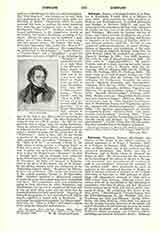

Schwann, THEODOR, German physiologist and founder of the theory of the cellular structure of animal organisms; b. at Neuss, December 7, 1810; d. at Cologne, January 11, 1882. He studied medicine at Bonn, where one of his teachers was the celebrated physiologist John Muller, and also at Wurzburg, and at Berlin where he obtained his degree in 1834. His dissertation for the doctorate on the breathing of the embryo of the hen in the egg, “De necessitate orris atmosphaerici ad evolutionem pulli in ovo incubato” attracted the attention of the medical world. After graduation he acted as assistant in the anatomical museum at Berlin; in 1839 he became professor of anatomy at the Catholic University of Louvain; in 1848 professor of physiology and comparative anatomy at Liege and in 1880 retired from teaching. Schwann proved that animal cells are in morphological and physiological accordance with those of plants, and that all animal tissues proceed partly from cells and are partly composed of them. He established this theory in his chief work: “Mikroskopische Untersuchungen fiber die Ubereinstimmung in der Struktur and dem Wachstum der Tiere and Pflanzen” (Berlin, 1839). Before this, John Purkinje (1787-1569) had pointed out the analogy between the nuclei of the animal cell and of the plant, cell, still Schwann deserves the credit of having developed and established this theory. Kolliker’s cellular physiology and Virchow’s cellular pathology. are based, on Schwann’s theory. Schwann also discovered the cells of the nails and feathers, what are called the Tomes fibres of the teeth, the nuclei of the smooth and striped muscle-fibres, and the envelope of the nerve-fibres (Schwann’s envelope). Moreover, in 1836 he discovered that pepsin was the substance that produced albuminous digestion in the stomach; in 1844 he produced the first artificial gastric fistula, and called attention to the importance of the gall in digestion. He discovered the organic nature of yeast at the same time as Cagniard Latour, although independently of the latter, and proved that the yeast-cells take the material necessary for reproduction and development from the substance capable of fermentation. In a separate treatise he proved the weakness of the theory of spontaneous generation. Besides the works already mentioned Schwann wrote a number of papers for medical journals and for the reports of the Belgian Academy.
LEOPOLD SENFELDER

